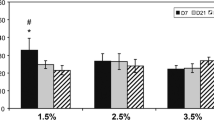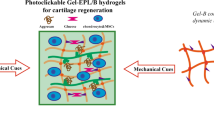Abstract
The goal of this work is to develop an injectable nucleus pulposus (NP) tissue engineering scaffold with the ability to form an adhesive interface with surrounding disc tissue. A family of in situ forming hydrogels based on poly(N-isopropylacrylamide)-graft-chondroitin sulfate (PNIPAAm-g-CS) were evaluated for their mechanical properties, bioadhesive strength, and cytocompatibility. It was shown experimentally and computationally with the Neo-hookean hyperelastic model that increasing the crosslink density and decreasing the CS concentration increased mechanical properties at 37 °C, generating several hydrogel formulations with unconfined compressive modulus values similar to what has been reported for the native NP. The adhesive tensile strength of PNIPAAm increased significantly with CS incorporation (p < 0.05), ranging from 0.4 to 1 kPa. Live/Dead and XTT assay results indicate that the copolymer is not cytotoxic to human embryonic kidney (HEK) 293 cells. Taken together, these data indicate the potential of PNIPAAm-g-CS to function as a scaffold for NP regeneration.








Similar content being viewed by others
References
Bao Q, McCullen GM, Higham PA. The artificial disc: theory, design, and materials. Biomaterials. 1996;17(12):1157–67.
Kalb C. The great back pain debate. Newsweek. 2004;143(17):42–9.
Bogduck N. Clinical anatomy of the lumbar spine and sacrum. Fourth edition ed. Oxford: Elsevier Churchill Livingstone; 2005.
Cramer G, Darby SA. Basic and clinical anatomy of the spine, spinal cord, and ans. St. Louis: Elsevier Mosby; 2005.
Benneker L, Heini PF, Alini M, Anderson SE. Young investigator award winner: vertebral endplate marrow contact channel occlusions and intervertebral disc degeneration. Spine. 2005;30(2):167–73.
Osti O, Vernon-Roberts B, Moore R, Frasier RD. Annular tears and disc degeneration in the lumbar spine. J Bone Joint Surg. 1992;74B:678–82.
Li-Wei X, Fang H, Chen A, Li F. Differentiation of rat adipose tissue-derived mesenchymalstem cells towards a nucleus pulposus-like phenotype in vitro. Chin J Traumatol. 2009;12(2):98–103.
Feng G, Jin X, Hu J, Ma H, Gupte MJ, Liu H, Ma PX. Effects of hypoxias and scaffold architecture on rabbit mesenchymal stem cell differentiation towards a nucleus pulposus-like phenotype. Biomaterials. 2011;32:8182–9.
Meisel H, Ganey T, Hutton W, Moseley T, Hedrick M, (eds) (2007) Nucleus pulposus regeneration using fresh autologous adipose derived cells. Abstracts of ICRS. Warsaw, 2007.
Ganey T, Libera J, Moos V, Alasevic O, Fritsch KG, Meisel HJ, Hutton WC. Disc chondrocyte transplantation in a canine model: a treatment for degenerated or damaged intervertebral disc. Spine. 2003;28:2609–20.
Crevensten G, Walsh AJ, Ananthakrishnan D, Page P, Wahba GM, Lotz JC, Berven S. Intervertebral disc cell therapy for regeneration: mesenchymal stem cells implantation in rat intervertebral discs. Ann Biomed Eng. 2004;32:43–434.
Horner H, Roberts S, Bielby RCD, Menage J, Evans H, Urban JPG. Cells from different regions of the intervertebral disc: effect of culture system on matrix expression and cell phenotype. Spine. 2002;27:1018–28.
Zhang C, Dike R, Zhang R, Wang S, Yang F (eds) (2008). Tissue-engineered composite of three dimensional PLGA scaffold seeded with nucleus pulposus cells for intervertebral disc regeneration. Proceedings of the NASS 23rd Annual Meeting; 2008: The Spine Journal.
Richardson S, Curran JM, Chen R, Vaughan-Thomas A, Hunt JA, Freemont AJ, Hoyland JA. The differentiation of bone marrow mesenchymal stem cells into chondrocyte-like cells on poly-l-lactic acid (PLLA) scaffolds. Biomaterials. 2006;27:4069–78.
Wan Y, Fenga G, Shena F, Laurencin C, Lia X. Biphasic scaffold for annulus fibrosus tissue regeneration. Biomaterials. 2008;29:643–52.
Borges A, Eyholzer C, Duc F, Bourban PE, Tingaut P, Zimmerman T, Pioletti DP, Mason JAE. Nanofibrillated cellulose composite hydrogel for the replacement of the nucleus pulposus. Acta Biomater. 2011;7:3412–21.
Richardson S, Hughes N, Hunt JA, Freemont AJ, Hoyland JA. Human mesenchymal stem cell differentiation to NP-like cells in chitosan–glycerophosphate hydrogels. Biomaterials. 2008;29:85–93.
Collin E, Grad S, Zeugolis DI, Vinatier CS, Clouet JR, Guicheux JJ, Weiss P, Alini M, Pandit AS. An injectable vehicle for nucleus pulposus cell-based therapy. Biomaterials. 2011;32:2862–70.
Revell P, Damien E, Di Silvio L, Gurav N, Longinotti C, Ambrosio L. Tissue engineered intervertebral disc repair in the pig using injectable polymers. J Mater Sci Mater Med. 2007;18:303–8.
Klara P, Ray CD. Artificial nucleus replacement: clinical experience. Spine. 2002;27:1374–7.
Bertagnoli R, Schonmayr R. Surgical and clinical results with the PDN prosthetic disc-nucleus device. Eur Spine J. 2002;11(Suppl 2):S143–8.
Nerurkar N, Elliott DM. Mauck RL Mechanical design criteria for intervertebral disc tissue engineering. J Biomech. 2010;43:1017–30.
Ayano E, Karaki M, Ishibarab T, Kanazawa H, Okano T. Poly (N-isopropylacrylamide)–PLA and PLA blend nanoparticles for temperature-controllable drug release and intracellular uptake. Colloids Surf B. 2012;99:67–73.
Lue S, Chen CH, Shih CM, Tsaia MC, Kuo CY, Lai JY. Grafting of poly(N-isopropylacrylamide-co-acrylic acid) on micro-porous polycarbonate films: regulating lower critical solution temperatures for drug controlled release. J Membr Sci. 2011;379(1–2):330–40.
Fu G, Soboyejo WO. Investigation of swellable poly (N-isopropylacrylamide) based hydrogels for drug delivery. Mater Sci Eng C. 2011;31(5):1084–90.
Galperin ALT, Garty S, Ratner BD. Synthesis and fabrication of a degradable poly(N-isopropyl acrylamide) scaffold for tissue engineering applications. J Biomed Mater Res A. 2012. doi:10.1002/jbm.a.34380.
Klouda L, Perkins KR, Watsona BM, Hacker MC, Bryant SJ, Raphael RM, Kasper FK, Mikos AG. Thermoresponsive, in situ cross-linkable hydrogels based on N-isopropylacrylamide: fabrication, characterization and mesenchymal stem cell encapsulation. Acta Biomater. 2011;7(4):1460–7.
Kim S, Healy KE. Synthesis and characterization of Injectable poly(N-isopropylacrylamide-co-acrylic acid) hydrogels with proteolytically degradable cross-links. Biomacromolecules. 2003;4:1214–23.
Muramatsu K, Wada T, Hirai H, Miyawaki F. Poly(N-isopropylacrylamide-co-N-tert-butylacrylamide)-grafted hyaluronan as an injectable and self-assembling scaffold for cartilage tissue engineering. J Biomed Sci Eng. 2012;5:639–46.
Vernengo J, Fussell GW, Smith NG, Lowman AM. Evaluation of novel injectable hydrogels for nucleus pulposus replacement. J Biomed Mater Res B. 2008;84B(1):64–9.
Conova L, Vernengo J, Jin Y, Himes TB, Neuhuber B, Fischer I, Lowman A. A pilot study of poly(N-isopropylacrylamide)-g-polyethylene glycol and poly(N-isopropylacrylamide)-g-methylcellulose branched copolymers as injectable scaffolds for local delivery of neurotrophins and cellular transplants into the injured spinal cord. J Neurosurg Spine. 2011;. doi:10.3171/2011.7.SPINE11194.
Joshi A, Fussell G, Thomas J, Hsuan A, Lowman A, Karduna A, Vresilovic E, Marcolongo M. Functional compressive mechanics of a PVA/PVP nucleus pulposus replacement. Biomaterials. 2006;27:176–84.
Comolli N, Neuhuber B, Fischer I, Lowman A. In vitro analysis of PNIPAAm–PEG, a novel, injectable scaffold for spinal cord repair. Acta Biomater. 2009;5:1046–55.
Vernengo J, Fussell G, Smith NG, Lowman AM. Synthesis and characterization of injectable bioadhesive hydrogels for nucleus pulposus replacement and repair of the damaged intervertebral disc. J Biomed Mater Res B. 2010;93B(2):309–17.
Matsuda S, Iwata H, Se N, Ikada Y. Bioadhesion of gelatin films crosslinked with glutaraldehyde. J Biomed Mater Res. 1999;45:20–7.
Herget G, Kassaa M, Riedeb UN, Lua L, Brethnera L, Hassea J. Experimental use of an albumin-glutaraldehyde tissue adhesive for sealing pulmonary parenchyma and bronchial anastomoses. Eur J Cardiothorac Surg. 2001;19:4–9.
Chanda M, Rempel GL. A new method of gel-coating polyethyleneimine (PEI) on organic resin beads.High capacity and fast kinetics of PEI gel-coated on polystyrene. Ind Eng Chem Res. 2001;40:1624–32.
Chang Y, Tsaib C, Liangb H, Sung H. In vivo evaluation of cellular and acellular bovine pericardia fixed with a naturally occurring crosslinking agent (genipin). Biomaterials. 2002;23:2447–57.
Godbey W, Wu KK, Mikos AG. Size matters: molecular weight affects the efficiency of poly(ethylenimine) as a gene delivery vehicle. J Biomed Mater Res. 1999;45:268–75.
Bieber T, Elsasser HP. Preparation of a low molecular weight polyethylenimine for efficient cell transfection. Biotechniques. 2001;30:74–81.
Ronca F, Palmieri L, Panicucci P, Ronca G. Anti-inflammatory activity of chondroitin sulfate. Osteoarthritis Cartilage. 1998;6(Suppl A):14–21.
Pipitone V. Chondroprotection with chondroitin sulfate. Drugs Exp Clin Res. 1991;17:3–7.
Moss M, Kruger GO, Reynolds DC. The effect of chondroitin sulfate on bone healing. Oral Surg Oral Med Oral Pathol. 1965;20:795–801.
Lee C, Huang CP, Lee YD. Synthesis and characterizations of amphiphilic poly(l-lactide)-grafted chondroitin sulfate copolymer and its application as drug carrier. Biomol Eng. 2007;24:131–9.
Gonzales A, Anguiano-Igea S, Otero-Espinar FJ, Mendez JB. Chitosan and chondroitin microspheres for oral-administration controlled release of metoclopramide. Eur J Pharm Biopharm. 1999;48:149–55.
Rubinstein A, Nakar D, Sintov A. Chondroitin sulfate: potential biodegradable carrier for colon-speci®c drug delivery. Int J Pharm. 1992;84:141–50.
Gupta N, Ghute PP, Badiger MV. Synthesis and characterization of thermo-sensitive graft copolymer of carboxymethyl guar and poly(N-isopropylacrylamide). Carbohydr Polym. 2011;83:74–80.
Vasile C, Nita LE. Novel multi-stimuli responsive sodium alginate-grafted-poly(N-isopropylacrylamide) copolymers: II. Dilute solution properties. Carbohydr Polym. 2011;86:77–84.
Duana C, Zhang D, Wang F, Zheng D, Jia L, Feng F, Liu Y, Wang Y, Tian K, WAng F, Zhang Q. Chitosan-g-poly(N-isopropylacrylamide) based nanogels for tumor extracellular targeting. Int J Pharm. 2011;409:252–9.
Varghese J, Ismalia YA, Lee CK, Shin KM, Shin MK, Kim SI, So I, Kim SJ. Thermoresponsive hydrogels based on poly(N-isopropylacrylamide)/chondroitin sulfate. Sens Actuators B. 2008;135:336–41.
Bryant S, Davis-Arehart KA, Luo N, Shoemaker RK, Arther JA, Anseth KS. Synthesis and characterization of photopolymerized multifunctional hydrogels: water soluble poly(vinyl alcohol) and chondroitin sulfate macromers for chondrocyte encapsulation. Macromolecules. 2004;37:6726–33.
Wang L, Shen SS, Lu SC. Synthesis and characterization of chondroitin sulfate–methacrylate hydrogels. Carbohydr Polym. 2003;52:389–96.
Ma X, Cui Y, Zhao X, Zheng S, Tang X. Different deswelling behavior of temperature-sensitive microgels of poly(N-isopropylacrylamide) crosslinked by polyethyleneglycol dimethacrylates. J Colloid Interface Sci. 2004;276:53–9.
ASTM. Standard test method for strength properties of tissue adhesives in tension. ASTM Int. 2005;F(2258-05):1308–12.
Chen J, Cheng T. Preparation and evaluation of thermo-reversible copolymer hydrogels containing chitosan and hyaluronic acid as injectable cell carriers. Polymer. 2009;50(1):107–16.
Vernon B, Kim SW, Bae YH. Thermoreversible copolymer gels for extracellular matrix. J Biomed Mater Res. 2000;51:69–79.
Umehara S, Tadano SP, Abumi KMD, Katagiri KMS, Kaneda KMD, Ukai TP. Effects of degeneration on the elastic modulus distribution in the lumbar intervertebral disc. Spine. 1996;21:811–9.
Johannessen W, Vresilovic EJ, Seguritan J, Elliott D. Altered nucleus pulposus mechanics using chondroitinase-ABC and genipin as a model of early disc degeneration. Trans Orthop Res Soc. 2004;29:1150.
Blanco M, Olmo R, Teijon JM. Hydrogels. In: Swarbrick J, editor. Encyclopedia of pharmaceutical technology. 2nd ed. New York: Marcel Dekker; 2004. p. 239–60.
Kinloch A. The science of adhesion. J Mater Sci. 1980;15:2141–66.
West J. Hubbell J comparison of covalently and physically cross-linked polyethylene glycol-based hydrogels for the prevention of postoperative adhesions in a rat model. Biomaterials. 1995;16:1153–6.
Peppas N, Buri PA. Surface, interfacial and molecular aspects of polymer bioadhesion on soft tissues. Control Release. 1985;2:257–75.
Strehin I, Nahas Z, Arora K, Nguyen T, Elisseeff J. A versatile pH sensitive chondroitin sulfate–PEG tissue adhesive and hydrogel. Biomaterials. 2010;31:2788–97.
Wang D, Varghese S, Sharma B, Strehin I, Fermanian S, Gorham J, Fairbrother DH, Cascio B, Elisseeff JH. Multifunctional chondroitin sulphate for cartilage tissue-biomaterial intergration. Nat Mater. 2007;6(5):385–92.
Varghese S, Hwang NS, Canver A, Theprungsirkul P, Lin DW, Elisseef J. Chondroitin sulfate based niches for chondrogenic differentiation of mesenchymal stem cells. Matrix Biol. 2008;27(1):12–21.
Hoogendoorn R, Kroeze RJ, Bank RA, Wuisman PI, Helde MN. Adipose stem cells for intervertebral disc regeneration: current status and concepts for the future. J cell Mol Med. 2008;12(6A):2205–16.
Author information
Authors and Affiliations
Corresponding author
Rights and permissions
About this article
Cite this article
Wiltsey, C., Kubinski, P., Christiani, T. et al. Characterization of injectable hydrogels based on poly(N-isopropylacrylamide)-g-chondroitin sulfate with adhesive properties for nucleus pulposus tissue engineering. J Mater Sci: Mater Med 24, 837–847 (2013). https://doi.org/10.1007/s10856-013-4857-x
Received:
Accepted:
Published:
Issue Date:
DOI: https://doi.org/10.1007/s10856-013-4857-x




